
A new molecule may soon enable tiny hard drives that store vastly more data. Withstanding extreme cold, it paves the way for dense and efficient storage solutions.
Researchers from The University of Manchester and The Australian National University (ANU) have developed a novel molecule capable of storing data at extremely low temperatures, comparable to the frigid conditions on the moon’s dark side at night.
Their results, published in Nature, point toward the potential for future data storage devices no larger than a postage stamp, yet capable of holding up to 100 times more information than today’s leading technologies.
“The new single-molecule magnet developed by the research team can retain its magnetic memory up to 100 Kelvin, which is about minus 173 degrees Celsius, or as cold as an evening on the moon,” co-lead author Professor Nicholas Chilton, from the ANU Research School of Chemistry, said.
“This is a significant advancement from the previous record of 80 Kelvin, which is around minus 193 degrees Celsius. If perfected, these molecules could pack large amounts of information into tiny spaces.
“Pink Floyd’s The Dark Side of the Moon was released in 1973. Technology has come a long way since then and nowadays we listen to music through new digital mediums such as Spotify and even TikTok.
“This new molecule could lead to new technologies that could store about three terabytes of data per square centimeter. That’s equivalent to around 40,000 CD copies of The Dark Side of the Moon album squeezed into a hard drive the size of a postage stamp, or around half a million TikTok videos.”
Responding to massive data demands
As internet use continues to rise, with more people streaming content, using social media, and uploading data to the cloud, the need for advanced information technology systems capable of handling vast volumes of digital information is rapidly increasing.

Magnetic materials have traditionally been central to data storage, with current hard drives relying on the magnetization of small areas composed of many atoms that work collectively to preserve information.
In contrast, single-molecule magnets can store data within individual molecules, eliminating the need for neighboring atoms and opening the door to significantly higher storage densities.
Bringing magnets closer to practicality
But the challenge has always been the incredibly cold temperatures required for them to function.
“While still a long way from working in a standard freezer, or at room temperature, data storage at 100 Kelvin, or about minus 173 degrees Celsius, could be feasible in huge data centers, such as those used by Google,” co-lead author Professor David Mills, from The University of Manchester, said.
“Although the new magnet still needs cooling far below room temperature, it is now well above the temperature of liquid nitrogen, a readily available coolant, which is 77 Kelvin, or around minus 196 degrees Celsius.
“So, while we won’t be seeing this type of data storage in our mobile phones for a while, it does make storing information in huge data centers more feasible.”

The key to the new magnets’ success is its unique structure, with the rare earth element dysprosium located between two nitrogen atoms. These three atoms are arranged almost in a straight line – a configuration predicted to boost magnetic performance but realized now for the first time.
Usually, when dysprosium is bonded to only two nitrogen atoms it tends to form molecules with more bent or irregular shapes. In the new molecule, the researchers added a chemical group called an alkene that acts like a molecular pin, binding to dysprosium to hold the structure in place.
Simulating quantum spin behavior
“At ANU, we’ve developed a new theoretical approach to simulate the molecule’s magnetic behavior, using only the fundamental equations of quantum mechanics, which has allowed us to explain why this particular molecular magnet performs so well compared to previous designs,” Professor Chilton said.
“We were able to achieve this by leveraging the massive computational resources of the National Computational Infrastructure at ANU and the Pawsey Supercomputing Research Centre in Western Australia, including their large banks of GPU-accelerated compute nodes, to simulate the time-dependence of the electron spins in this molecular material.
“This has enabled us to explain why this new molecule, with its linear arrangement of atoms at its core, can show magnetic memory at such high temperatures. This molecule will now serve as a blueprint moving forward to guide the design of even better molecular magnets that can retain their data at even higher temperatures.
“In the more than 50 years since the release of The Dark Side of the Moon, technology has progressed leaps and bounds. It’s exciting to think how technologies will continue to evolve in the next half a century.”
Reference: “Soft magnetic hysteresis in a dysprosium amide–alkene complex up to 100 kelvin” by Jack Emerson-King, Gemma K. Gransbury, Benjamin E. Atkinson, William J. A. Blackmore, George F. S. Whitehead, Nicholas F. Chilton and David P. Mills, 25 June 2025, Nature.
DOI: 10.1038/s41586-025-09138-0
Funding: European Research Council, the Leverhulme Trust, the UK EPSRC, the Australian Government, Government of Western Australia
Never miss a breakthrough: Join the SciTechDaily newsletter.
3 Comments
So, we’ll store huge amounts of data in a small space but if there’s a power or cooling failure that allows the temperature to rise, then all the data will be lost.
The fluff at the top of this article is really offputting. It took about 2 pages of scrolling past pink floyd references and pointless comparisons to the temperature on the dark side of the moon to get to the point. What demographic is this site targeting? This makes me consider whether or not I’m it.
Yes, there is no “Dark Side of the Moon.” While there is a far-side we never see from Earth, all of the Moon is illuminated by the sun throughout a month. Choosing a once-popular Pink Floyd album as a title and illustration is a poor choice. The question is whether one should blame the article author or SciTechDaily.